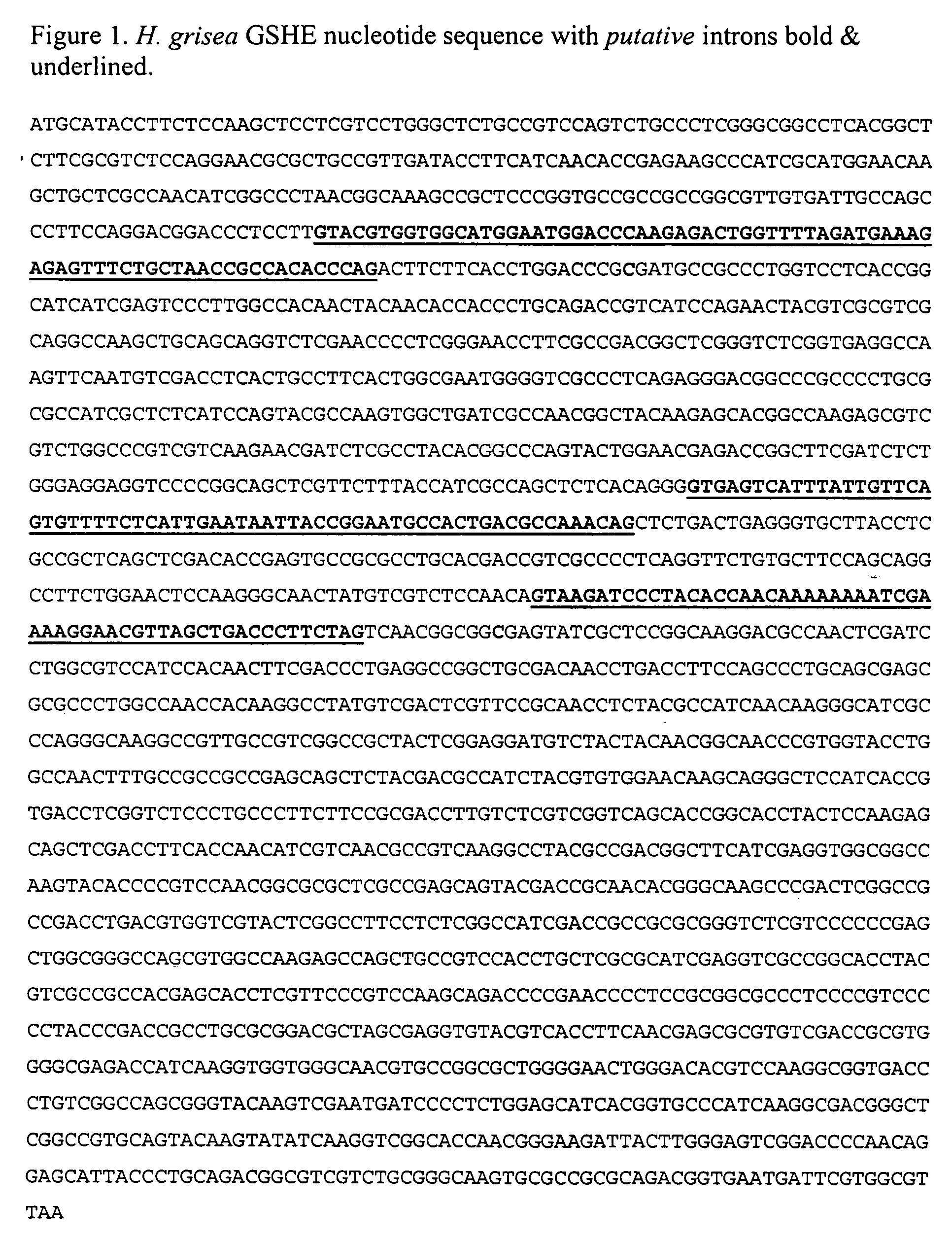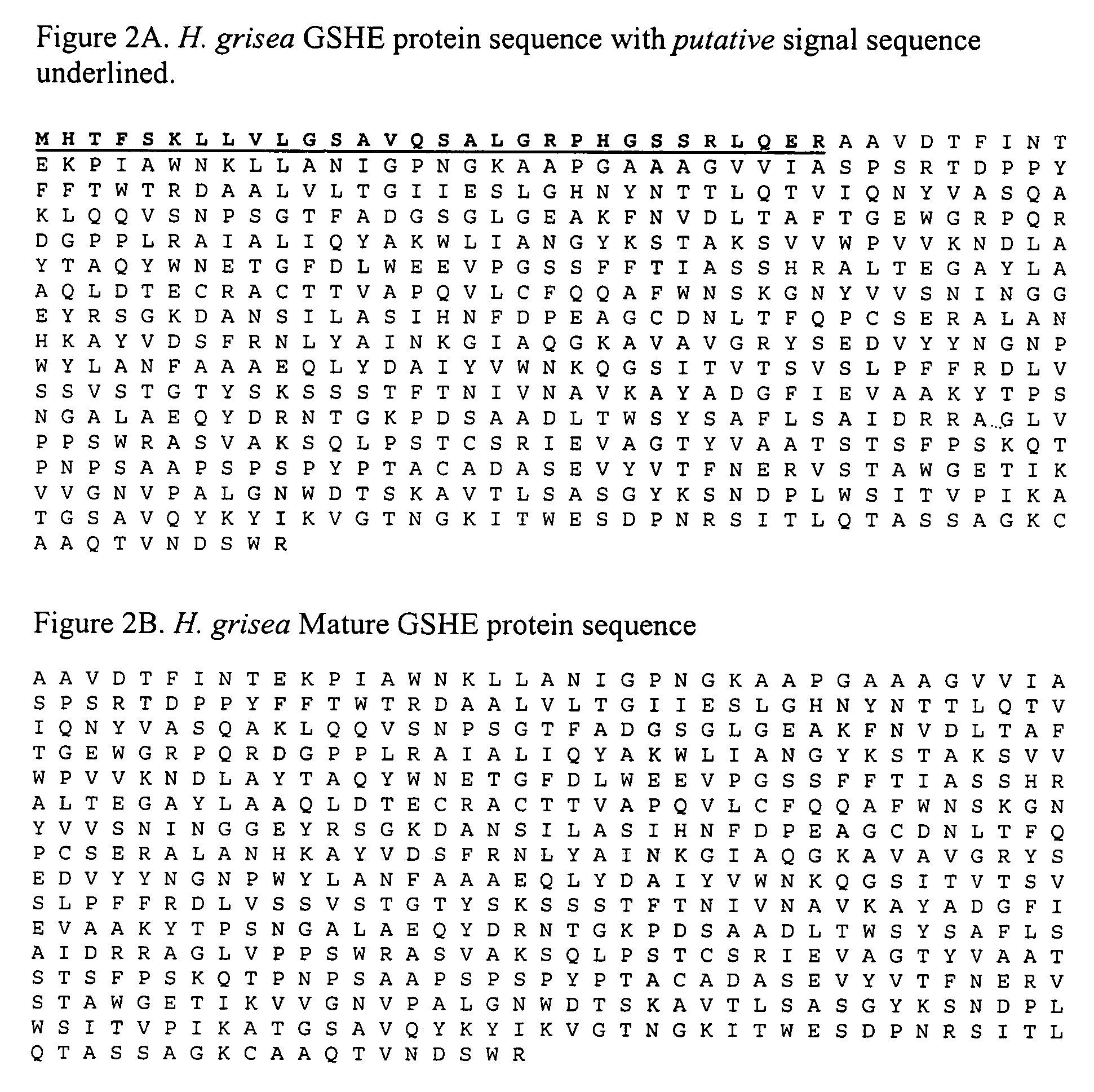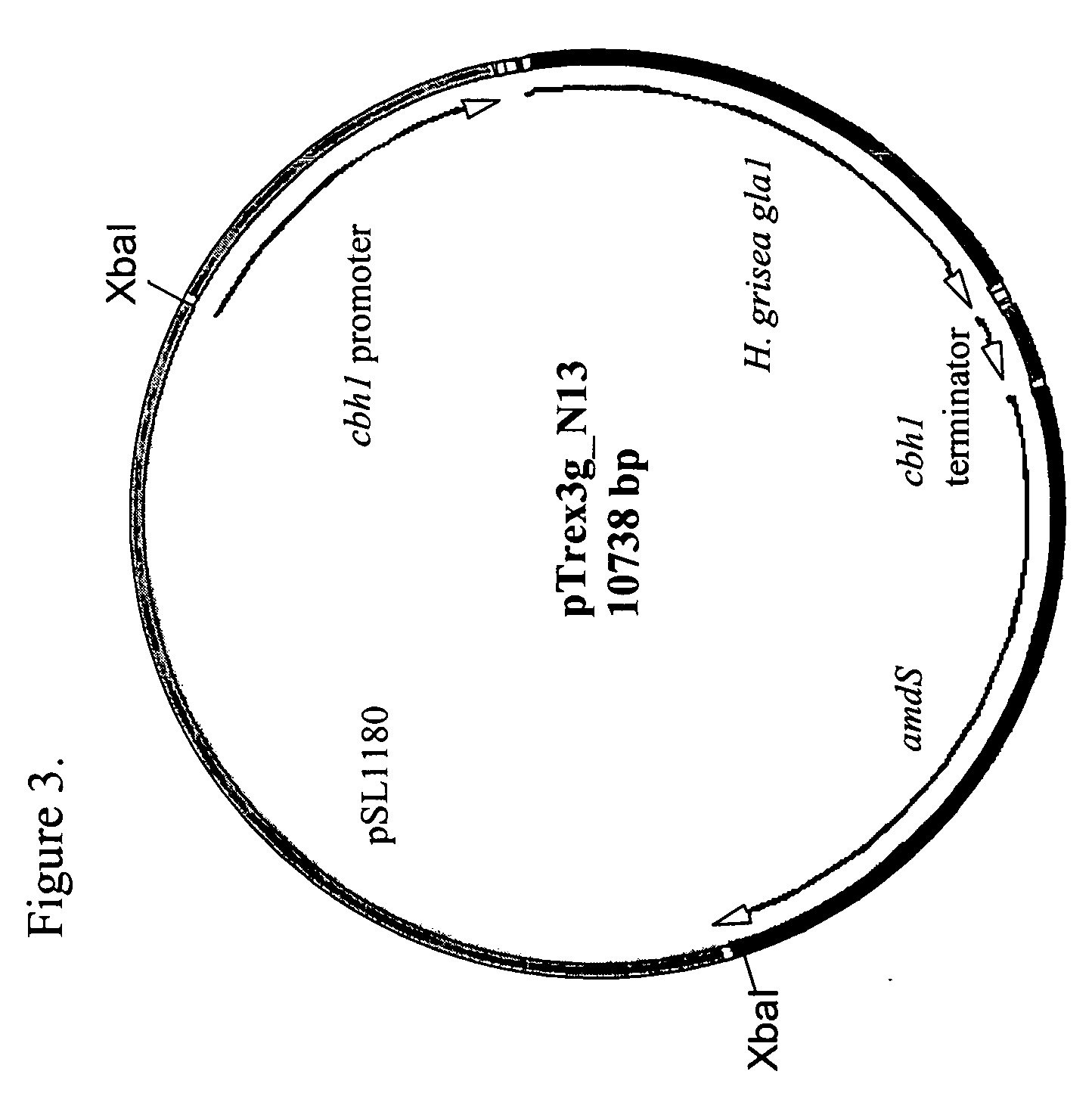Expression of granular starch hydrolyzing enzymes in Trichoderma and process for producing glucose from granular starch substrates
a technology of granular starch and hydrolyzing enzyme, which is applied in the field of filamentous fungal host cells, can solve the problems of liquefaction process alkaline isomerization of reducing groups, adverse effect on process efficiency, and partial hydrolysis of starch, so as to reduce the sugar content of liquefied starch, reduce the time of sugar syrup, and reduce the effect of high sugar conten
- Summary
- Abstract
- Description
- Claims
- Application Information
AI Technical Summary
Benefits of technology
Problems solved by technology
Method used
Image
Examples
example 1
Expression of Humicola grisea var. thermoidea GSHE Gene in Trichoderma reesei
[0195] A. Cloning of the Humicola grisea var. thermoidea GSHE gene Genomic DNA (SEQ ID NO: 1) was extracted from frozen Scytalidium thermophilum (ATCC 16453, anamorph, H. grisea var. thermoidea) mycelia. The frozen mycelia were ground with dry ice in a coffee grinder and the DNA was extracted by the EasyDNA protocol (Invitrogen). An extra chloroform / phenol / isoamyl alcohol extraction was added to the standard protocol. PCR primers were designed, based on the NCBI database accession #M89475 sequence. The forward primer contained a motif for directional cloning into the pENTR / D vector (Invitrogen).
[0196] The sequence of the RSH003f primer was CAACATGCATACCTTCTCCAAGCTCCTC (SEQ ID NO. 7) and the sequence of the RSH004r primer was TTAACGCCACGAATCATTCA CCGTC (SEQ ID NO. 8).
[0197] The PCR product was cloned into pENTR / D, according to the Invitrogen Gateway system protocol. The vector was then transformed into ch...
example 2
Expression of Aspergillus awamori var. kawachi GSHE Gene in Trichoderma reesei
[0228] A. Cloning the Aspergillus awamori var. kawachi GSHE gene
[0229] Genomic DNA was extracted from frozen mycelia of a strain of A. awamori var. kawachi according to the methods described in Example 1. The PCR primer sequences were designed based on the published sequence of the A. awamori var. kawachi glucoamylase GAI (Hayashida, et al. (1989) Agric. Biol. Chem. 53:923-929). This GAI is a GSHE. The following primers were used: the RSH10f primer having the sequence, CAC CAT GTC GTT CCG ATC TCT TCT C (SEQ ID NO:9), which includes the Gateway (Invitrogen) directional cloning motif CACC and the RSH11r primer having the sequence, CTA CCG CCA GGT GTC GGT CAC (SEQ ID NO:10).
[0230] The DNA sequence is provided in FIG. 6 (SEQ ID NO:4). The encoded GSHE polypeptide sequence, including the signal peptide, is provided in FIG. 7A (SEQ ID NO:5) and the mature protein sequence is provided in FIG. 7B (SEQ ID NO:6)....
example 3
Solubilization and Hydrolysis of Different Granular Starch Substrates by Alpha Amylase
[0240] In a typical experiment, 150 grams of granular starch were suspended in 350 grams of distilled water. After mixing, the pH was adjusted to pH 5.5 using 6 N NaOH. The alpha amylase (GZYME G997 at 1.0 kg / MT of starch, ds) was added to the starch slurry and incubated with constant stirring in a water bath maintained at 60° C. The samples were withdrawn at different time intervals for measuring the Brix. The sample withdrawn at 24 hrs was used to determine the sugar composition using HPLC (Table 6).
TABLE 6G Zyme G 997% Solids solublized% Carbohydrate Composition(0.1 kg / MT starch)Incubation time (hr)at 24 hrStarch substrate24691224DPIDP2DP3DP4+Corn32.239.342.949.252.853.90.612.015.072.4Tapioca46.650.853.656.158.262.41.611.614.672.2Wheat74.980.682.484.586.387.81.311.514.173.1
The results illustrated in Table 6 show significant differences in the solubilization of the granular starch substrates....
PUM
| Property | Measurement | Unit |
|---|---|---|
| temperature | aaaaa | aaaaa |
| temperature | aaaaa | aaaaa |
| temperature | aaaaa | aaaaa |
Abstract
Description
Claims
Application Information
 Login to View More
Login to View More - R&D
- Intellectual Property
- Life Sciences
- Materials
- Tech Scout
- Unparalleled Data Quality
- Higher Quality Content
- 60% Fewer Hallucinations
Browse by: Latest US Patents, China's latest patents, Technical Efficacy Thesaurus, Application Domain, Technology Topic, Popular Technical Reports.
© 2025 PatSnap. All rights reserved.Legal|Privacy policy|Modern Slavery Act Transparency Statement|Sitemap|About US| Contact US: help@patsnap.com



